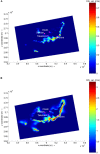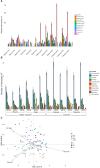Metagenomics of Coral Reefs Under Phase Shift and High Hydrodynamics
- PMID: 30337906
- PMCID: PMC6180206
- DOI: 10.3389/fmicb.2018.02203
Metagenomics of Coral Reefs Under Phase Shift and High Hydrodynamics
Abstract
Local and global stressors have affected coral reef ecosystems worldwide. Switches from coral to algal dominance states and microbialization are the major processes underlying the global decline of coral reefs. However, most of the knowledge concerning microbialization has not considered physical disturbances (e.g., typhoons, waves, and currents). Southern Japan reef systems have developed under extreme physical disturbances. Here, we present analyses of a three-year investigation on the coral reefs of Ishigaki Island that comprised benthic and fish surveys, water quality analyses, metagenomics and microbial abundance data. At the four studied sites, inorganic nutrient concentrations were high and exceeded eutrophication thresholds. The dissolved organic carbon (DOC) concentration (up to 233.3 μM) and microbial abundance (up to 2.5 × 105 cell/mL) values were relatively high. The highest vibrio counts coincided with the highest turf cover (∼55-85%) and the lowest coral cover (∼4.4-10.2%) and fish biomass (0.06 individuals/m2). Microbiome compositions were similar among all sites and were dominated by heterotrophs. Our data suggest that a synergic effect among several regional stressors are driving coral decline. In a high hydrodynamics reef environment, high algal/turf cover, stimulated by eutrophication and low fish abundance due to overfishing, promote microbialization. Together with crown-of-thorns starfish (COTS) outbreaks and possible of climate changes impacts, theses coral reefs are likely to collapse.
Keywords: coral reefs; early warning signals; hydrodynamics; local stressors; metagenomics; microbialization; resistence.
Figures




References
-
- Abe K. (2010). Desorptive behavior of phosphate in the subtropical Miyara river, Ishigaki Island, Japan. Limnology 11 179–183. 10.1007/s10201-009-0294-4 - DOI
-
- Arnold S. N., Steneck R. S., Mumby P. J. (2010). Running the gauntlet: inhibitory effects of algal turfs on the processes of coral recruitment. Mar. Ecol. Ser. 414 91–105. 10.3354/meps08724 - DOI
-
- Banzai K., Nakamura K. (2006). “Red soil runoff from the Miyarariver, and an environmental problem on Ishigaki island [Japan],” in JIRCAS International Symposium Series Proceedings (Japan) Ishigaki.
LinkOut - more resources
Full Text Sources
Miscellaneous

